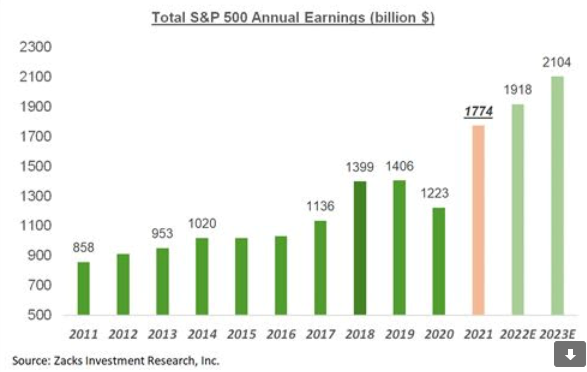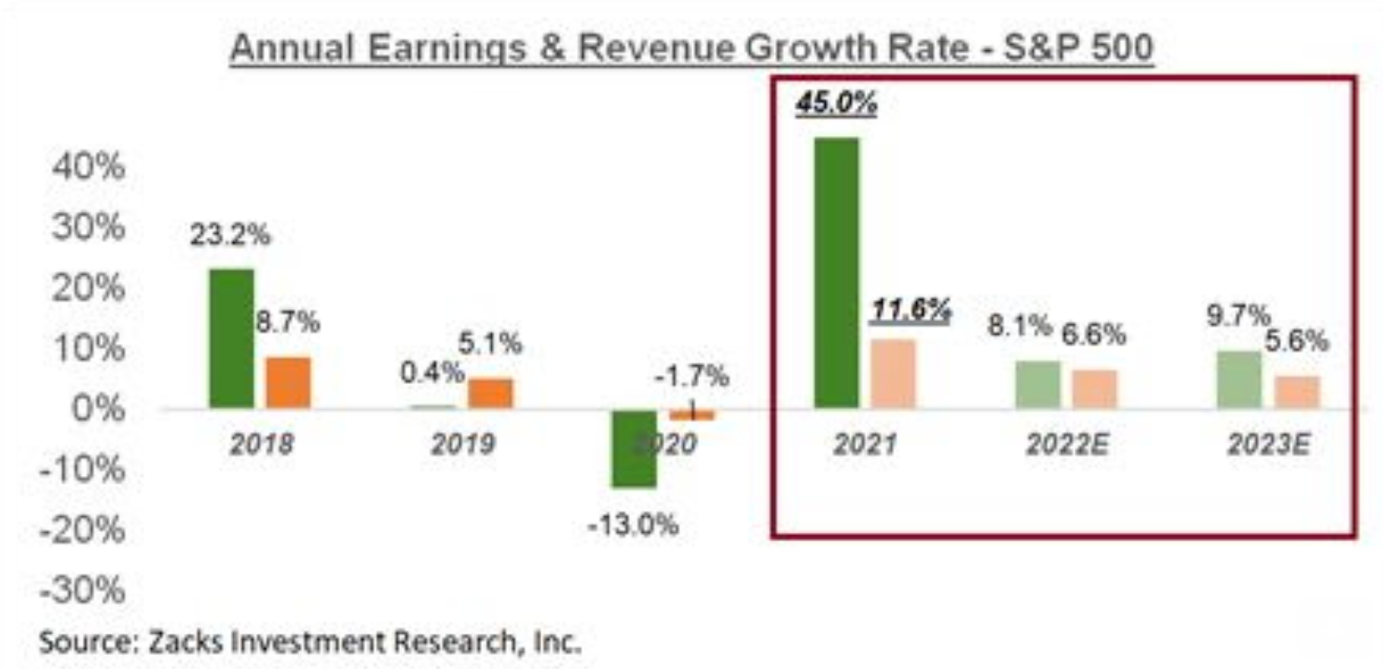Is The Investing Grass Greener Over The Fence?
The Investment Perspective – November 2021

Peter Flannery Financial Adviser CFP
“Neither the investing method nor the fundamentals of the business are right or wrong because the mood of the market is favourable or unfavourable toward the “stock”. That is because when you really think about it, “stocks” (shares) are all about the financials and the trading price, the share price… the cash up value. What matters more is the economics of the business”
Peter Flannery
Earnings Beats, Trading Prices, Intrinsic Value, and Noise
Key Points:
- Good news …
- But, what about crypto currency, bitcoin?
- There are many investment choices.
- Is the loudest one the best?
Good News People – The Outlook Looks Promising.
Total Earnings, Past and Present – S&P 500

The above graph shows total company earnings in billions of dollars from 2011 up to date and projections through 2023.
It has been said many times that the only two things that matter for stocks are earnings and interest rates. That has a ring of truth to it.
At the same time, there is more to it, and of course, we don’t play the share market. We prefer to invest in the business rather than the stock.
That said, whilst projections are only projections based on certain assumptions, the general outlook is favourable for earnings over the next couple of years.
Should this actually transpire, then we could expect this to push back against increases in interest rates to some degree.
Naturally, exactly how you will handle this information will somewhat be determined by your investing strategy and your investment risk temperament.
Anyway, the news is not all bad, even though we often hear in the popular media that either something risky is just around the corner or that “this will all end badly“…
Be Alert
Something to watch for in popular media is the use of valid statements mixed in with emotive language.
For example, stating that levels of global debt compared to 20 years ago are much higher, suggesting that the only outcome is a day of reckoning, or some sort of massive collapse is the narrative we often see promoted by clever internet jockeys who know how to grab our attention or educated academics who can eloquently articulate why it all can only end badly.
After all, we are herd animals that naturally want to follow the herd, the main stream. We make decisions based on our emotive instincts and rationalise with logic as though we are so developed, informed, educated and sophisticated.
By the way, ‘earnings beats’ is jargon for those who invest in the stock market by looking for analyst and share broker consensus estimates. They look to pick stocks that they think might beat sharebroker and analyst earnings estimates for the quarter. It is quite a useful technique for those that play the share market. It tends to be generally only of a short-term advantage often, but is not without merit.
Anyway, it highlights the point that whatever methodology we decide to use, the key to success is consistency and discipline around the methodology – not becoming distracted with some other “bright, shining new object” that turns out to be no better or worse than what we were already doing in the first place (it was just new and exciting).
Trading Prices
We’ve seen trading prices rise at pace over the last 18 months as the global markets quickly shrugged off the coronavirus and continue to focus on growth.
I know many of my clients, when they review their investment portfolios go straight to the bottom-line total cash up value and compare it with the last time they looked, to get a sense of whether they are making any progress or not.
Henry Ford is famous for watching his bank account. If the balance was growing, he was happy. If the balance was shrinking, he was unhappy.
The long-term batting average is what matters with regards to trading prices.
We need to be careful not to become caught up in the short-term (1 – 3 years) movement of trading prices and the cash up value of our portfolio. Otherwise, we could be led astray. That’s because historical price movement does not always reflect future price movement.
Years ago, we used to refer to this as rear-vision mirror investing. To be clear, you wouldn’t drive your motor vehicle down the road by looking at the rear vision mirror, if you see what I mean.
Intrinsic Value
Most investing methodologies hold intrinsic value in little regard, although it is often mentioned – in many instances, quite wrongly. The valuation methodologies used often across the markets are not a measure of intrinsic value but some other variation.
Discounted cash flow is common; price-to-book is another one.
At WISEplanning we used a combination of standard financial analysis and valuation ratios that you might be familiar with, mixed in with our analysis of the economics of each business. That provides us with what we regard as a realistic valuation process that we can rely on.
To be clear, financial analysis and the common ratios that are often used are useful but have significant limitations when we understand what the intrinsic value actually means.
The business is a function of the intrinsic value. It can be considered to be a combination of the numbers (financial analysis) and the business economics (e.g., the competitive advantage, the brand strength, the ecosystem).
In the short term, of course, the trading price is absolutely determined by market sentiment.
Longer-term though, the quality of the business determines the pace of trading price movement.
More specifically, businesses are capital assets that have an income stream (earnings / profits), and an amount of capital deployed that generates that income.
At the heart of it is the relationship between the capital deployed and the profit generated. Obviously, the higher the level of profit (earnings) generated for every dollar of capital deployed to generate that profit, the better the business. This is particularly the case in the long run.
Price movement, on the other hand, tells us little / nothing about the business.
In the end, the money we make as investors is determined by the performance of the business. Those businesses that use capital more effectively tend to provide the returns that we want in the long run.
Of course, there are other ways that we can invest. Other methodologies. However, what matters is that we have a methodology that works. This methodology needs to cope with any number of changes in market and economic conditions, keep our capital secure as well as allow it to grow over time.
That’s where taking chances, betting big and going for home runs / king-hits can work at times in a big way ( e.g. crypto currency) but is a game of chance — not investing.
The Noise
At the moment, rising property prices, rising share prices, cryptocurrencies, NFT’s, and other new ways to invest are making a loud noise and becoming louder.
It reminds me back in the day of cherry farms, goat farming, investing in gold, the share market, silver, Ostridge’s.
I remember some calculations around Ostridge’s showing that in the fullness of time, in order to continue the returns that were being achieved in the early years, the industry would need to clear much more available land across the planet and eventually begin Ostridge farms on the moon to be able to continue with those initial lofty annual returns long term.
Bitcoin, Ethereum, and other cryptocurrencies are becoming part of the investing landscape. We are seeing large corporations and wealthy individuals invest heavily. What do they know that you and I don’t?
Nothing as far as I can see. At least nothing obvious that is not already in the public domain.
I’m not sure about you, however, I know some of my clients have taken a small amount of money and dabbled with Bitcoin.
I’m neither for cryptocurrencies nor against cryptocurrencies. I’m not particularly interested in having another asset class personally. There are already too many asset classes that don’t offer much value. For example, I wonder where gold now fits into the investment landscape with the development of cryptocurrencies and especially Bitcoin?
As I’ve mentioned elsewhere, the mechanism around Bitcoin looks sustainable, at least in the short to medium term.
Longer-term, it’s difficult to know.
Bitcoin could be successful for another 30 years for all we know. That said, I am not convinced that the prevailing theory around Bitcoin offers certainty about the long-term future of Bitcoin.
However, I’m sure you’ve heard all about the millions of dollars that early punters have made and continue to make as the strong and growing demand for Bitcoin drives the price ever higher.
What happens to the trading price of Bitcoin if another newer better Bitcoin emerges? What might that mean for the trading price of Bitcoin and the cash up value?
I enjoyed an article sent to me recently by a client in Christchurch which refers to the old idea around ‘the mousetrap’. Hmmmm, I wonder what that means!?
Some More Good News
I’m not one for relying on projections or earnings beats; however, they provide some information about the market consensus and possible market direction.
Still though, we need to be careful because, this is somewhat superficial information that doesn’t necessarily tie in with the underlying performance of the business.
For example, profit and profitability are two totally different things. Earnings beats are based on profit – not profitability. That is one reason why earnings beats are interesting but generally of short term value. Quarterly profits come and go.
That said, I would be more comfortable relying on earnings growth than I would be on trading price movement (rear vision mirror investing etc.).
Earnings and Revenue Growth – S&P 500

The above graph shows annual earnings and revenue growth. The green bar is earnings (profit), the orange bar is revenue (turnover).
There are numerous grey swans floating about, which I mentioned in the latest Market and Economic Update.
In the midst of my preparation for portfolio reviews this month, the Fed governor Jerome Powell has signaled that tapering is now underway as expected. The market has already factored this into expectations, and so hence trading prices stay at around all-time highs.
Agree or disagree with it all, the US Fed in my view is doing a good job of helping stabilise the US economy and therefore the global economy.
Anyway, I thought, given the amount of dodgy negative banter that floats around the markets, I would start and finish today with some good news around expected earnings growth continuing (see the graph above).
This means that, all things equal, providing these projections play out, the pent-up demand from the pandemic recession is only part of the story and continues to dissipate as the months go by. What this means then is that earnings growth is progressively more fundamental, driven by economic activity and good old fashioned business growth.
Less Is More
Watch out for distractions that sidetrack you from the main game. That would be your methodology and the discipline around that method. Speculating is not the same thing as investing. They are totally different.
Ignore the noise, stay focused on what we know works… keep life simple.
“The secret of happiness you see, is not found in seeking more, but in developing the capacity to enjoy less.”
Socrates
